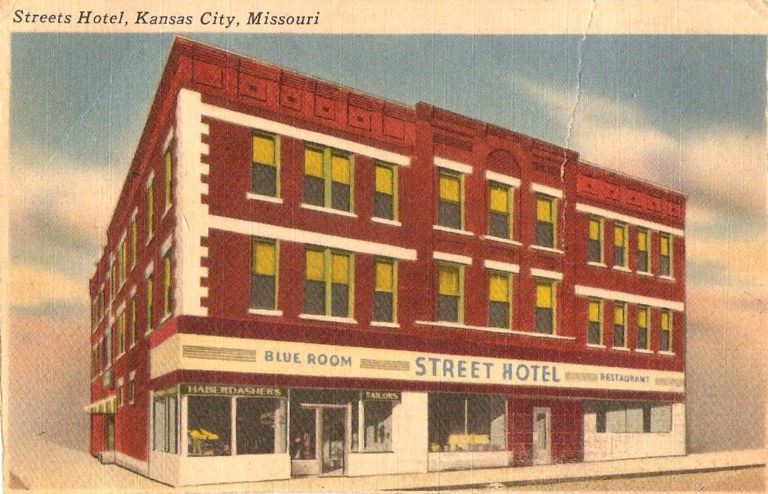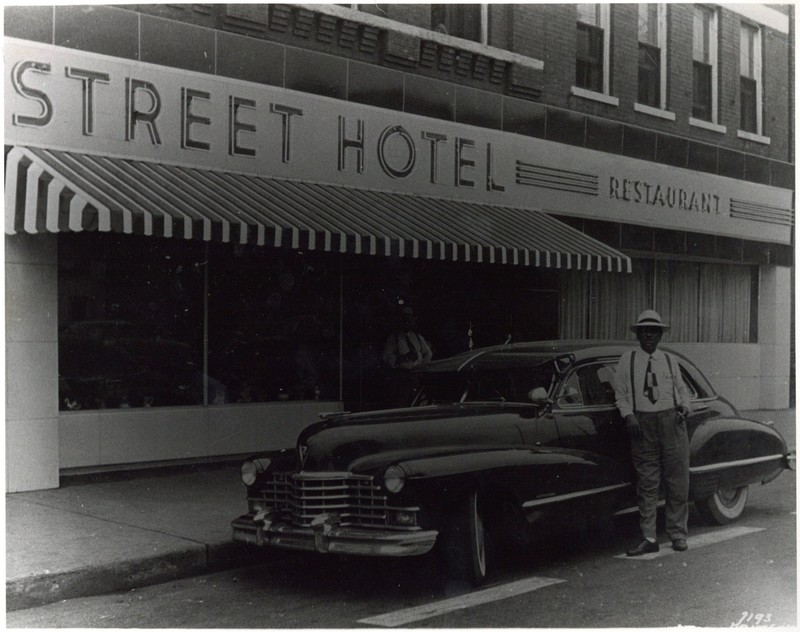Street Hotel (1923-1960)
Introduction
Author-Uploaded Audio
Introduction to the hotel and its history by Michael Patton; recording created by Black Archives of Mid-America
Text-to-speech Audio
Though the building itself is no longer there, the legacy of 18th and Vine's Street Hotel is one of the most enduring parts of the district. Opening in the early 1920s, the Street Hotel began life in 1903, as a restaurant opened by Reuben and Della Street at 18th and Troost. After several successful years of business, the couple decided to expand. They moved the restaurant to a building at the corner of 18th and the Paseo, which they first leased before purchasing the building for $67,000. The Streets ran the Hotel, which included the Blue Room Cocktail Lounge and Restaurant, for several decades, hosting numerous musicians and public figures, including Jackie Robinson, who played for the Kansas City Monarchs at the time. The Streets also became important figures in Kansas City at this time, playing host to numerous African-American action groups and participating in the overall growth of the 18th and Vine area. Unfortunately, the 1953 death of Della Street prompted her husband to sell the hotel the following year. The hotel would be sold again when the new owner defaulted on the mortgage, prompting the building to be sold at auction in 1960. Though it has since been razed to make room for new development, the legacy of the Street Hotel has left an indelible mark on 18th and Vine, as well as the greater Kansas City area.
Images
This postcard was sent to City Hall with the request that it be donated to the Black Archives of Kansas City

Reuben Street (right) standing next to a car in front of the Street Hotel, date unknown.

Backstory and Context
Text-to-speech Audio
The origins of the Street Hotel are intimately tied to the life story of the man who would become its proprietor. According to a Northeast News article from 2019, Reuben Street was born on January 1st, 1876 in Nashville, Tennessee, to a Reverend father. Street moved several times throughout his childhood, first to a farm in what is now the Armourdale neighborhood of northern Kansas City, where he helped his family sell produce to local eateries and other businesses. Sometime after this, the thirteen year-old Street got a job as a porter at a hotel in McPherson, KS, beginning a long career in the service industry. Two years later, Street moved to Chicago, where he worked in various restaurant roles before moving again to Indianapolis. In Indianapolis, Street met his wife Della, who would also become his staunchest business partner. In 1903, the couple moved to Kansas City, where they opened the precursor to the Blue Room at 18th and Troost.
As the restaurant continued to thrive, the Streets moved from the initial location to the iconic location at 18th and The Paseo. For the next roughly two and a half decades, the Streets leased the building and grew the reputation of their establishment. According to the African-American History Trail of Kansas City, Street purchased the building outright for $67,000 in cash in 1947, declaring his intent to remodel the building into “the most complete hotel for Negro patrons in the country.” A postcard advertising the building states that the hotel had "60 rooms with private bath and telephone service. Conveniently located on the first floor [were]: a Haberdasher, a Tailor, Post Office, and the famous Blue Room Cocktail Lounge and Restaurant." During this time, the Street Hotel played host to numerous notables in all walks of Kansas City life. In the mid-1940s, Jackie Robinson lived at the hotel during his tenure with the Kansas City Monarchs. The Blue Room also hosted dinners and event for political and community groups, including the Kansas City Public Service Company’s “Colored Division.” (AAHTKC) Additionally, the Street Hotel was listed in the Negro Motorist Green Book as one of the safe places for African-American travelers to stay in Kansas City.
Unfortunately, the era of the Street Hotel's prominence came to an end in 1954. Following the death of his wife a year before, Reuben Street sold the hotel to real estate investor Robert Williams. However, Williams was unable to pay the mortgage on the hotel, and the building wound up being sold at a public auction in 1960 for $58,000. According to the African-American History Trail of Kansas City, this was the first time the building had been owned by a white person. After this, the timeline of the building's use becomes unclear, though National Register of Historic Places documents state that the building was torn down by the early 1980s, contributing to a broader issue of blight in the area. Now, the area at the corner of 18th and Paseo has been replaced by an open patio space, and the Blue Room lives on as part of the American Jazz Museum, where it continues to host the best of the Kansas City Jazz scene.
Sources
Bushnell, Michael. “The Streets Hotel Was Listed in 'Green Book'.” Northeast News, February 26, 2019. http://northeastnews.net/pages/streets-hotel-listed-green-book/.
Lee, Bradford. “Jackie Robinson's Year in Kansas City.” Royals Review. Royals Review, February 7, 2019. https://www.royalsreview.com/2019/2/7/18212636/jackie-robinsons-year-in-kansas-city.
National Register of Historic Places, 18th and Vine Historic District, Kansas City, Jackson County, MO, National Register #84004142
“Street Hotel.” African American Heritage Trail of Kansas City. Accessed December 12, 2022. https://aahtkc.org/street-hotel.
http://northeastnews.net/pages/streets-hotel-listed-green-book/
Photo courtesy of the Black Archives of Mid-America
